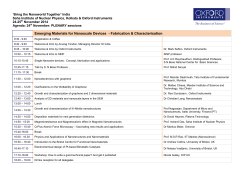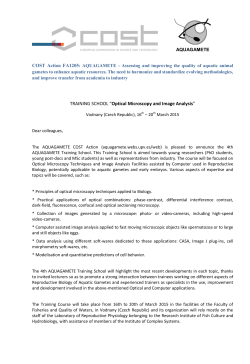
CH_451_syllabus - The Cooper Union
Chemistry 451, Nanomaterials Prof. Marcus D. Lay, mlay@cooper.edu, Phone: 212.353.4375, Office 415 Office Hours: 2:00 - 3:00 Tuesday and Thursday, or by appointment. Email is also a good way to contact me. Learning Objectives: This course will introduce undergraduate science and engineering majors to the rapidly growing area of nanoscience and nanotechnology, the study and manipulation of matter on an atomic and molecular level. At this scale, materials often exhibit new properties that do not exist in their large-scale counterparts. Therefore, there is a great focus on the formation and characterization of “nanomaterials” for use in a wide array of new and enhanced electronic, biomedical, and structural applications. Fundamental and applied research in nanomaterials is an area of active research that will yield many new discoveries in the near future. Nanoscience is an interdisciplinary field, as it involves research at the interface between chemistry, engineering, physics, and biology. Therefore, although the structure of this course assumes a basic freshman/sophomore-level understanding of chemistry and physics, it is intended as an introductory course, so no prior experience with the subject matter is assumed. The course will focus on understanding the physical properties, and methodologies for the formation (i.e. molecular self-assembly, photolithographic patterning, electrochemistry), and characterization of nanomaterials (i.e. UV-vis-near IR spectroscopy, atomic force microscopy, scanning tunneling microscopy, Raman spectroscopy, and scanning electron microscopy). A significant portion of this course will also involve learning to search peer-reviewed scientific literature to obtain a fundamental understanding of an area related to nanoscience that is not covered in class. Then, this knowledge will be integrated into a brief oral presentation and a ½-page abstract that explains your topic at a level appropriate for an audience of non-specialists (at the level you would explain it to someone having no experience with your field of interest). To assist in this exercise, there will be a lecture on how to use the internet resources available through the science library to find literature and cite papers in your abstract. These skills will be quite useful in your future careers as scientists. Course Lecture Notes and Text: You can find course lecture notes and other materials by logging into your moodle account. There is no text required for this class, but as an additional resource, you have free oncampus access to the following text: Nanoscience, the Science of the Small in Physics, Engineering, Chemistry, Biology and Medicine, Schaefer, 2010 (http://www.springerlink.com/content/978-3-642-10558-6/contents/) Class Participation: I encourage discussion in class. Please feel free to ask questions, during and after class. Additional Help: Feel free to discuss the course material and ask questions of any members of the Lay research group. They are very busy, but I am sure they are willing to talk science with you and show you around our lab. Additional Resources: Books: Introduction to Nanoscience, Hornyak, Dutta, Tibbals and Rao, 2008. Understanding Nanomaterials, Johal, 2011. Scanning Probe Microscopy in Nanoscience and Nanotechnology, edited by Bharat Bhushan, 2010 (click the link for free on-campus access) Peer-Reviewed Journals: Science, Nature, Nano Letters, Journal of Physical Chemistry C, Journal of the American Chemical Society, Angewandte Chemie, Chemistry of Materials, Langmuir, Nature Materials 1 Websites: www.nano.gov, nanohub.org, www.nanotechweb.org, www.nanowerk.com Grading: Exams: 40% (there are no makeup exams or quizzes) Quizzes/Homework: 10% Presentation/Written Abstract: 30/10% Your course average will be calculated based on the exams, quizzes, presentations and any other assignments. Your overall course grade will be determined with respect to performance based on class norms. Tests: Your scores on the two in-class exams will each count for 20% of your overall grade. The dates for these exams are tentatively set as follows: Feb. 28th, April 24th, Final: May 3rd, 8:00 - 11:00 am Your grade will reflect your level of work in this course, not any outside influences. Work hard from the start, as small differences in performance can make a big difference in your grade. Quizzes/Homework: There will be occasional pop quizzes worth a total of 10% of your final grade. The quizzes are unannounced and cover work from recent previous lectures or presentations. Attendance: Attendance is not mandatory, but I give pop quizzes, especially if there are many people absent. Further, important information and announcements about the class will be made during the lectures. Tentative Course Schedule: Introduction Course overview What are nanoscience & nanotechnology? Why are they so interesting? The important role of the microelectronics industry in the drive for miniaturization. Surface/volume relationships and quantum confinement effects in nanomaterials. Classifications of nanomaterials. Solutions, colloids and suspensions. Micro- and Nano-Lithography Clean room processes used for making patterns needed for electronic materials. Top-down vs. bottom up methods. Optical lithography. Electron-beam lithography. Scanning probe lithography. Types of resists and their exposure modes. How semiconductors, diodes, and transistors work. Moore’s Law. Self-Assembled Monolayers (SAMs) Building patterns and changing surface properties with molecular building blocks. How and why molecules spontaneously form ordered structures on surfaces. Low Miller Index Planes and surface adsorption sites for Au. Thiol and silane self-assembly. Applications of SAMs in surface modification and molecular electronics. Science Library Primer 2 Dr. Ian Thomas will present Web of Science, SciFinder Scholar, Google Scholar, and using Endnote/RefWorks with MS-Word. Carbon Nanotubes and Graphene What are they? Where do they come from? Do they come in peace? Their fundamental physical properties and electronic applications. Analytical techniques used in their characterization: scanning electron microscopy (SEM), transmission electron microscopy (TEM), UV-Vis-NIR spectroscopy, and Raman spectroscopy. Exam #1 Dynamic Ranges of Common Microscopy Methods Optical microscopy. Electron microscopy. Scanning probe microscopy. Importance of vibration isolation in microscopy. Scanning Probe Microscopy (SPM) A proximal probe is used to image, characterize and/or manipulate atoms and molecules. Atomic Force Microscopy (AFM) The optical lever detection mechanism. Instrument design & basic principles. Types of AFM cantilevers and tips. Contact, intermittent contact, and non-contact modes. Effect of the contamination layer on “real world” surfaces on each AFM imaging mode. Force calibration plots. Imaging artifacts. AFM image analysis. Scanning Tunneling Microscopy (STM) Classical Theory vs. Quantum Mechanics. Quantum tunneling theory. Instrument design & basic principles. Height mode vs. current mode. STM in air, liquid and ultra-high vacuum. Imaging artifacts: Atomic resolution in graphene vs. graphite. Image analysis. Electrochemistry in Nanoscience Linear vs. radial diffusion. How the electrochemical behavior of isolated and arrays of nanoscaled electrodes distinguishes them from larger electrodes. Exam #2 3 Presentation: The final exam will be composed of a brief oral presentation of a recent literature topic related to nanoscience and/or nanotechnology (see list below for available topics). There will also be a brief abstract (1 page maximum, including references) of a topic related to nanoscience (see below for available topics). This exercise is designed for you to gain experience explaining your area of interest at a level that can be understood by a multidisciplinary audience. Your talk and paper should incorporate information from at least three recent peer-reviewed articles (from the last five years) that are related to your chosen subject. This exercise is an opportunity for you to explore a topic that interests you. Examples of previous abstracts will be given in class. Remember that your overall goal for any presentation and/or manuscript is to teach the observer something new about a subject that is of great interest to you. The path you take prior to presenting that new information will make a huge difference in how effective you are. Be sure that your presentation provides a brief overview of the fundamental principles, as well as the application to a broad audience. Be sure to assume that the listener is not an expert in your field. You may find this outline useful: 1. Introduction a. Title slide should have your name and affiliation (verbally thank organizers) 1. Verbally summarize your presentation in 1 or 2 sentences b. Start at an appropriate level. Know your audience and have at least one slide explaining why your topic should be of interest to them. c. Explain the impetus for your specific research - What is the scientific problem you are concerned with? How does your presentation’s focus relate to previous work? Does this represent an incremental increase in knowledge, or a new direction? d. Theory & applications - how does it work? What are its physical properties? What are some of its applications? 2. Results and Discussion a. Present and discuss your new data. Provide experimental setup information and needed. 3. Summary and/or Future Directions a. Concisely tie together your main points and provide a sense of closure 1. What are your contributions to new knowledge? In very general terms, what are the next steps? b. Acknowledgments - a slide a acknowledging the support of your coworkers If your focus is an analytical technique, be sure to provide the class with a brief overview of the fundamental operating principles, sensitivity, operating environments, types of samples, advantages/disadvantages, etc. If your focus is a type of nanoscaled material or biological system, explain the basics at a level appropriate for undergraduate science majors who are outside of that field. Plan for your talk to last 15 minutes. Consider this “practice” for your future talks. It’s okay to “borrow” figures from articles or websites, but the source must be cited on the slide. Every slide should have a title. Every slide should deliver a key message. Remember that the slides are there to guide you along your chosen path, not for you to read to the audience or for the audience to read in-depth explanations. So, keep the writing short and designed only to remind you of your key points. You are the focus of the talk and the slides are there to demonstrate your points; “a picture is worth a thousand words.” Possible topics in nanoscience. Solar energy conversion using nanoparticles Electrochemisty of nanoscaled electrodes Single molecule conduction measurements Aerogels 4 Quantum dots (synthesis, or physical properties) Supramolecular self-assembly Inorganic nanowires Magnetic nanoparticles Dip-pen nanolithography Microcontact printing Graphene (synthesis, or physical properties) Corrosion prevention with nanoparticles Molecular electronics: single electron transistors Graphene nanoribbons Colloids Biomolecular Nanoscience Scanning electrochemical microscopy (SECM) Natural Nanomaterials Colors seen in butterfly wings Lotus Leaves DNA templated materials synthesis Gecko feet (how they stick to surfaces) Electrostatic force microscopy Spider silk Two-dimensional nanosheets Surface enhanced Raman spectroscopy (SERS) for detection of biomarkers Scanning ion conductance microscopy (SICM, protein surface charge mapping) Block copolymers Nanogrinding Nanoscience in Dentistry (choose a topic) Nanomedicine (choose a topic) Energy storage with nanoparticles Academic Honesty: We expect students at the Cooper Union to adhere to the highest standards of academic honesty and integrity. All work presented by you in this course is expected to be your own best effort, unless you are specifically instructed to work with other students on a particular problem. Copying of the work of others, and particularly plagiarism, which is the use of the work of others without proper credit or citation, will not be tolerated. The penalty for plagiarism or other academic dishonesty will be assignment of an F grade on the assignment and in the course, and may include suspension or expulsion from Cooper Union. All incidents of academic dishonesty will be reported to the Dean of Engineering and your advisors. It is recommended that you familiarize yourself with the Cooper Union Code of Conduct. 5
© Copyright 2025











